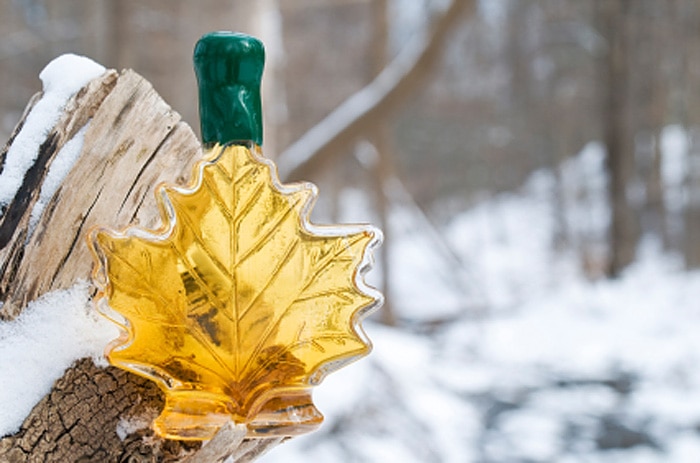
Written By: Sofia Layarda, MPH
Title: Master of Public Health
Alumni: University of California, Berkeley
Last Updated on:

Everyone seems to be on the lookout for the next big alternative sweetener. Enter maple syrup. Produced naturally with nothing added, it comes from a 100% plant source and is therefore a vegan-friendly sweetener. But is there any truth to the hype around its health benefits?

Table of Contents
All the maple syrup in the world is produced in North America. The main producer is the Canadian province of Quebec, which produces 85% of the world supply. in the U.S., maple syrup is produced in several New England states and New York. Maple syrup results when sap from maple trees (main species Acer saccharum) is allowed to lose most of its water content through evaporation. Approximately 40 gallons of sap are needed to produce 1 gallon of maple syrup. Sap by volume is 2.5% sugar, while maple syrup is 66% sugar.
In both Canada and the U.S., maple syrup has three grades and five color classifications. (Quebec also has its own provincial grading system, but this is not used outside of the province). The following table compares the corresponding U.S. and Canadian maple syrup grades.
| U.S. Grade A Light Amber/Fancy | Canada No. 1 Extra Light |
| U.S. Grade A Medium Amber | Canada No. 1 Light |
| U.S. Grade A Dark Amber | Canada No. 1 Medium |
| U.S. Grade B Commercial | Canada No. 2 Amber |
| U.S. Grade B Commercial | Canada No. 2 Dark |
The lightest syrup is produced at the beginning of the season. As the season progresses, the color darkens and the taste gets stronger. The most popular grade of syrup is U.S. Grade A Dark Amber (Canada No. 1 Medium). The Grade B syrups have much stronger flavors and are generally used in cooking or food processing only.
Interestingly, maple syrup is considered a low-GI food (it has a glycemic index of 54), which means it does not raise blood sugar as quickly as regular table sugar (which has a GI of 95). For comparison, honey has a GI of 77. Maple syrup is an excellent source of the trace mineral manganese; 1 tablespoon contains approximately half of the DRI for this nutrient.
A 2010 University of Quebec study of maple syrup’s antioxidant capacity showed that the ORAC (antioxidant capacity) of pure maple syrup was comparable to that of strawberry juice and orange juice but lower than that of blueberry juice. The same study found that maple syrup showed anti-inflammatory and anti-cancer properties, with the anti-inflammatory effects appearing stronger in the darker syrup.
Small changes are needed when you use maple syrup in place of sugar. Chef Daniel Lagarde of Do More with Maple provides the following substitution tips when baking with maple syrup:
Many of us drizzle maple syrup on pancakes, toast, or waffles, but there are other uses for maple syrup in the kitchen. Chef Mark Reinfeld of Vegan Fusion shares the following ideas:
Maple syrup can be a substitute for regular sugar, but its role is certainly that of a sweetener rather than an antioxidant source. While it’s not exciting to repeat, vegetables and fruits continue to be the main source of antioxidants in your diet. Pure maple syrup can be pricey, but if you want to try it, definitely look for the real thing and avoid “maple-flavored” syrups, which contain little or no actual maple syrup.
Alumni: University of California, Berkeley – Sofia believes in bringing back fun and pleasure into everyday eating. She loves cooking, and is constantly experimenting with ingredients, creating recipes and trying them out on family and friends. Her latest interest lies in finding realistic and practical ways of environmentally-friendly food/eating habits.
antioxidant, grocery aisle, home cooking, sweeteners